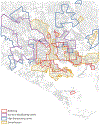Inequitable Housing Practices and Youth Internalizing Symptoms: Mediation Via Perceptions of Neighborhood Cohesion
- PMID: 37033410
- PMCID: PMC10081151
- DOI: 10.17645/up.v7i4.5410
Inequitable Housing Practices and Youth Internalizing Symptoms: Mediation Via Perceptions of Neighborhood Cohesion
Abstract
Disordered urban environments negatively impact mental health symptoms and disorders. While many aspects of the built environment have been studied, one influence may come from inequitable, discriminatory housing practices such as redlining, blockbusting, and gentrification. The patterns of disinvestment and reinvestment that follow may be an underlying mechanism predicting poor mental health. In this study, we examine pathways between such practices and internalizing symptoms (i.e., anxiety and depression) among a sample of African American youth in Baltimore, Maryland, considering moderation and mediation pathways including neighborhood social cohesion and sex. In our direct models, the inequitable housing practices were not significant predictors of social cohesion. In our sex moderation model, however, we find negative influences on social cohesion: for girls from gentrification, and for boys from blockbusting. Our moderated mediation model shows that girls in gentrifying neighborhoods who experience lower social cohesion have higher levels of internalizing symptoms. Likewise for boys, living in a formerly blockbusted neighborhood generates poorer social cohesion, which in turn drives higher rates of internalizing symptoms. A key implication of this work is that, in addition to standard measures of the contemporary built environment, considering other invisible patterns related to discriminatory and inequitable housing practices is important in understanding the types of neighborhoods where anxiety and depression are more prevalent. And while some recent work has discussed the importance of considering phenomena like redlining in considering long-term trajectories of neighborhoods, other patterns such as blockbusting and gentrification may be equally important.
Keywords: Baltimore; anxiety; blockbusting; depression; gentrification; internalizing symptoms; neighborhood social cohesion; redlining.
Conflict of interest statement
Conflict of Interests The authors declare no conflict of interests.
Figures



Similar articles
-
Linking Historical Discriminatory Housing Patterns to the Contemporary Alcohol Environment.Appl Spat Anal Policy. 2023;16(2):561-581. doi: 10.1007/s12061-022-09493-9. Epub 2022 Dec 6. Appl Spat Anal Policy. 2023. PMID: 36532713 Free PMC article.
-
Linking historical discriminatory housing patterns to the contemporary food environment in Baltimore.Spat Spatiotemporal Epidemiol. 2021 Feb;36:100387. doi: 10.1016/j.sste.2020.100387. Epub 2020 Nov 5. Spat Spatiotemporal Epidemiol. 2021. PMID: 33509435 Free PMC article.
-
Neighborhood Gentrification and Food Insecurity Among Urban Older Adults: Evidence From New York City.Gerontologist. 2024 Jul 1;64(7):gnae048. doi: 10.1093/geront/gnae048. Gerontologist. 2024. PMID: 38761043
-
The effects of contemporary redlining on the mental health of Black residents.SSM Popul Health. 2023 Jun 29;23:101462. doi: 10.1016/j.ssmph.2023.101462. eCollection 2023 Sep. SSM Popul Health. 2023. PMID: 37456619 Free PMC article.
-
Urban health inequality in shifting environment: systematic review on the impact of gentrification on residents' health.Front Public Health. 2023 Jul 20;11:1154515. doi: 10.3389/fpubh.2023.1154515. eCollection 2023. Front Public Health. 2023. PMID: 37546305 Free PMC article.
Cited by
-
Neighborhood Cohesion and Symptoms of Anxiety Across Racial/Ethnic Groups in the United States.J Community Psychol. 2025 Feb;53(2):e70000. doi: 10.1002/jcop.70000. J Community Psychol. 2025. PMID: 39949199 Free PMC article.
-
Neighborhood Physical and Social Environments and Social Inequalities in Health in Older Adolescents and Young Adults: A Scoping Review.Int J Environ Res Public Health. 2023 Apr 11;20(8):5474. doi: 10.3390/ijerph20085474. Int J Environ Res Public Health. 2023. PMID: 37107756 Free PMC article.
-
Association of Public Works Disasters with Substance Use Difficulties: Evidence from Flint, Michigan, Five Years after the Water Crisis Onset.Int J Environ Res Public Health. 2023 Nov 21;20(23):7090. doi: 10.3390/ijerph20237090. Int J Environ Res Public Health. 2023. PMID: 38063520 Free PMC article.
References
-
- Acevedo-Garcia D, Osypuk TL, Werbel RE, Meara ER, Cutler DM, & Berkman LF (2004). Does housing mobility policy improve health? Housing Policy Debate, 15(1), 49–98.
-
- Alegría M, Green JG, McLaughlin KA, & Loder S (2015). Disparities in child and adolescent mental health and mental health services in the US. William T. Grant Foundation.
-
- Beck AT, & Steer RA (1990). Manual for the Beck anxiety inventory. Psychological Corporation.
Grants and funding
LinkOut - more resources
Full Text Sources
